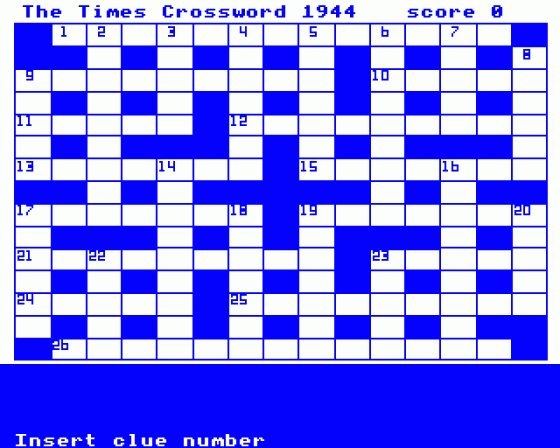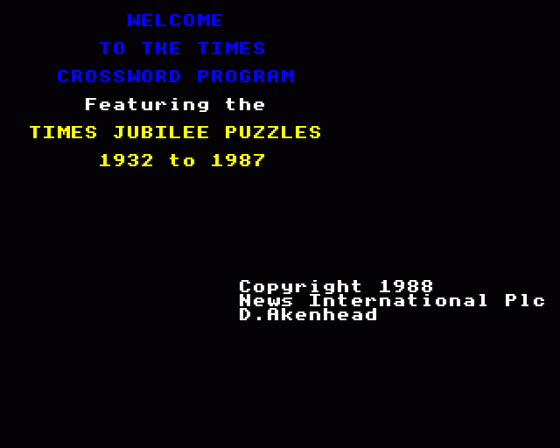
Electron User
 1st September 1988
1st September 1988
Categories: Review: Software
Author: Nic Outterside
Publisher: Akom
Machine: BBC/Electron
Published in Electron User 5.12
I suppose it was only a matter of time before these magnificent word puzzles found their way on to the micro. They have now arrived in all their glory with 60 crossword puzzles on each of volumes one and two, and 56 puzzles on the Jubilee Puzzles edition.
In fact, the Jubilee Puzzles should become a valuable collector's item, as they feature one superb crossword taken each year from 1932 to 1987 inclusive. The effort involved to bring all these crosswords to your computer is quite a feat in itself.
I remember stolidly typing in a crossword compiler from the October 1986 issue of Electron User and being astounded at the clever programming used by its author. However, that was child's play compared to the labours of David Akenhead who is the creator of this fine collection.

This software is not just for the expert crossword solver, thanks to comprehensive instruction booklets and four graded levels of play. In fact you need not solve the crosswords at all, but simply investigate, clue by clue, the construction of each puzzle.
The Times Computer Crosswords could also have an educational application within the sphere of vocabulary extension at GCSE level English.
Reading the instructions is an essential prerequisite to play, as the programs operate some clever options. The booklets contain a glossary of convention indicators and abbreviations used within the puzzles, as well as an introduction to the devices used in cryptic crosswords.

Upon loading the disc or cassette you are presented with an introductory page and then asked to insert the puzzle number of your choice. With over 170 crosswords to choose from, in these three packages, you are rather spoilt for choice!
I suggest that all players attempt puzzle number one to begin with, as a blow by blow analysis is contained within the instruction booklet. This also gives an insight for novices into the construction and convention indicators used within such a puzzle.
Upon choosing your crossword the grid is assembled in stunning clarity, a score line is set to zero and an invisible clock begins timing your progress.
The instruction "Insert clue number" appears, with the accompanying option of down or across. You are now operating at level one and the clue appears together with the words "Help? Y/N".
If you enter N you may then go ahead and attempt to solve the clue, for which you will be awarded 50 points for a correct solution or a time penalty if incorrect.
If you answer Y, you proceed to level two of the program and a marker option is presented. If this is accepted you may enter any letters you know and fill any spaces in that answer with chevrons.
You may of course, return to that clue later in the game. If however, you solve it at this level, 40 points are awarded.
Should you decline the marker option the program assumes you require more help. Now at level three you may ask for a convention indicator and may solve the clue for 30 points or mark as before.
However, if you are still stuck, you are offered the solution to that clue, which, if accepted, is printed in the grid and 30 points deducted from your score.
Conversely, you may continue to level four where the first letter of the answer is printed in the grid. This gives you the opportunity to solve the clue for 10 points.
You may leave the game at any level, in which case the screen clears to reveal an analysis of your performance. This appears in terms of time taken, the number of clues solved by both yourself and the computer, the score and an assessment of your expertise in the categories: Beginner, average, good, very good and expert.
You are also offered the option of viewing the entire solution before progressing to another puzzle or leaving the program. The graphic representation in these puzzles is attractive and precise and computer response time is extremely fast.
This must be the crossword equivalent to White Knight or Colossus Bridge. To be compared to those two masterpieces in serious games programming is a true testament to the quality of The Times Computer Crosswords.
Whether you are of championship status in the art of solving cryptic crosswords or a novice to this genre, these packages represent excellent purchases.
Other Reviews Of The Times Crosswords Jubilee Puzzles For The BBC/Electron
The Times Crosswords Jubilee Puzzles (Akom)
A review by Dave Reeder (A&B Computing)



